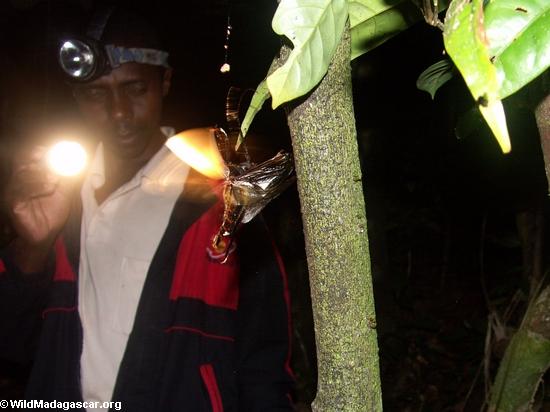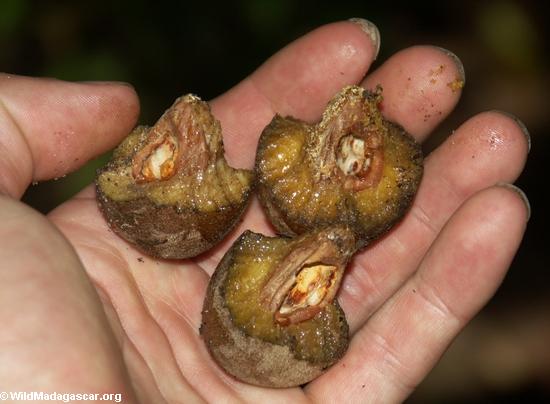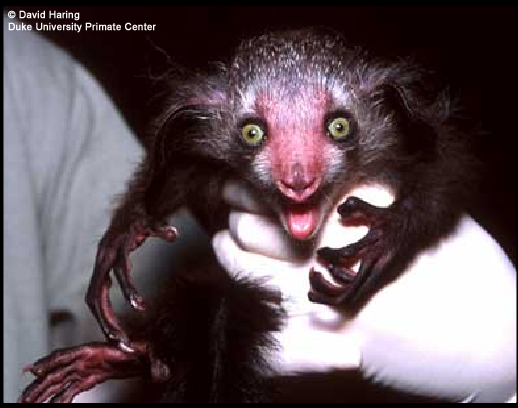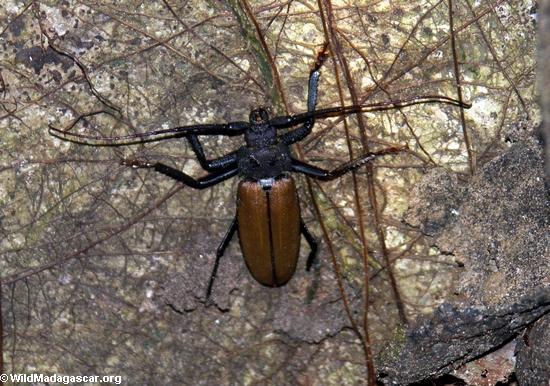Madagascar has been called the “land that time forgot” for its collection of unique and often downright bizarre plants and animals. Around 75% of the species on the island are found nowhere else on Earth, putting Madagascar atop the list among the world’s most biologically diverse countries. Madagascar is famous for its lemurs, a group of primates endemic to the island.
Among these lemurs is one of the planet’s strangest beasts, the aye-aye. This nocturnal and reclusive lemur looks like it has been assembled from a variety of animals. The aye-aye resembles a large house cat but with the face of a ferret or weasel, bat-like ears capable of rotating independently, teeth that grow constantly like those of a rodent, piercing green eyes, and black hands featuring a bony middle finger reminiscent of a dead twig. The aye-aye uses this finger for locating insect larvae that lurk deep inside tree bark, seeds, and fruit. As it climbs along a tree branch, the aye-aye taps the bark while listening for cavities in the wood. When it hears something potentially appetizing beneath the surface, the aye-aye gnaws away at the wood in search of its prize. Studies suggest that the aye-aye is capable of sensing insect movement at a depth of 12 feet.
The aye-aye’s biology is so strange that scientists did not know what to make of the animal when it was described in 1782. Scientists first classified the aye-aye as rodent before realizing that it was just a really peculiar lemur that deserved its own family, Daubentoniidae. In the past, there was a second, larger species of aye-aye. But this species, like more than dozen other species of large lemurs, went extinct after the arrival of humans in Madagascar less than 2000 years ago.
|
Befriending an Aye-aye
Gerald Durrell’s encounter The late Gerald Durrell, a prominent naturalist, had an amazing first encounter with the aye-aye. He describes his experience in his book The Aye-aye and I, “Then, to my alarm, it discovered my ear. ‘Here’ is seemed to say to itself, ‘must lurk a beetle larva of royal proportions and of the utmost succulence.’ It fondled my ear as a gourmet fondles a menu and then, with great care, it inserted its thin fingers. I resigned myself to deafness — move over, Beethoven, I said to myself, here I come. To my astonishment, I could hardly feel the finger as it searched my ear like a radar probe for hidden delicacies. Finding my ear bereft of tasty and fragrant grubs, it uttered another faint ‘humph’ of annoyance and climbed up into the branches again.”
|
Today, like many of Madagascar’s species, the aye-aye is at high risk of going extinct. Habitat loss, combined with persecution by locals as an omen of bad luck (see box) has decimated aye-aye populations across Madagascar. In an effort to stave off its demise, in 1966, six animals were moved to Nosy Mangabe Special Reserve, an island lying about 2 km off the coast of Maroantsetra in northeastern Madagascar in the Bay of Antongil. The ecologists hoped to establish a breeding population of aye-ayes before the species disappeared from the mainland. It has since been found that aye-aye have a wider distribution than initially believed.
In late October 2004, I traveled to Nosy Mangabe, which is one of the best places to see wild aye-aye today. The island, forested with tropical rainforest and having a rich history involving 17th century pirates, lies close enough to the town of Maroantsetra for a day trip, though an night-time stay is crucial if you hope to see the aye-aye. There are no lodging facilities on the island for visitors (a small research station is available for visiting scientists), but there are several covered platforms where you can pitch tents as well as restrooms and showers.
This was not my first visit to this island nor my first attempt to see the aye-aye. During my 1997 trip, I spotted a pair of aye-aye along the beach of Nosy Mangabe as well as enjoying a rare sighting of a mother with baby along a road outside Andasibe park — we nearly ran over them as we motored back to our lodge on a cold August night. Both sightings proved to be remarkable experiences.
Nosy Mangabe
  
[top] Nosy Mangabe seen from the beach near Maroantsetra; [middle] Beach on Nosy Mangabe; [bottom] Map of Nosy Mangabe Photos copyright Rhett Butler. |
I arrive on Nosy Mangabe following a few of days on the Masoala
Peninsula. The Masoala has Madagascar’s largest protected tract of
rainforest and accordingly, some the highest diversity of species on
Earth. It is a beautiful area; the forest extending down to the long
white sand beaches, and just offshore lie coral reefs and breeding grounds
for humpback whales.
After setting up our tents, we spent the afternoon exploring Nosy
Mangabe and observing some of the island’s other wildlife. In addition
to the nocturnal aye-aye, other lemurs on the island include
the black-and-white ruffed lemur and the white-fronted brown
lemur — both of which are active during the day. Black-and-white
lemurs are also found on the mainland of Madagascar, as far south as
Ranomafana National Park. Strangely, despite the island’s proximity
to the Masoala peninsula, black-and-white lemurs are not found there.
Instead they are replaced with the red ruffed lemur, a closely related,
but genetically distinct lemur with dark red fur. Like the aye-aye,
some mystery surrounds the black-and-white ruffed lemurs of Nosy
Mangabe. No one is sure how long these lemurs have been on the
island. Some believe they were introduced in the 1930s, but others
point to reports from British indicating their presence as far back as
the 17th century.
The forests of Nosy Mangabe are home to a spectacular array of other
animals including divergent geckos, color-shifting chameleons,
brightly-hued frogs, and a multitude of insects. Among the best-known
of the island’s creatures is the Uroplatus gecko, an animal so
well-camouflaged that it disappears against the trunks of trees. It is
difficult to believe that this cryptic lizard is in the same family as
the neon green day geckos found on nearby palm trees around the
island. Due to their remarkable characteristics, both these animals
are highly sought in the pet trade. Overzealous collecting for the
international reptile market has significantly reduced populations of
some “herp” (reptile and amphibian) species in Madagascar. My local
guide Armand comments that in the past, he has seen locals collecting
reptiles and amphibians from Nosy Mangabe and protected areas on the
Masoala peninsula.
|
|
||
More pictures from Nosy Mangabe |
||
Eco-tourism in Madagascar
Armand has been a guide in the Masoala region for over ten years —
before the peninsula was even designated as a national park. Over the
years he has led dozens of dignitaries and world-renowned scientists
through the rainforests and coral reefs of Masoala. Guiding is a well
respected and well-paid occupation in Madagascar and for good reason
— ecotourism is one of the great hopes for the economic development
of the country.

|
In Madagascar you are required to have a local guide when you enter a
protected areas. This is to ensure both your safety and enjoyment of
the surroundings as well as to provide employment opportunities for local
people. Because the country is very poor, conservation efforts have a
direct impact on local people who would otherwise use natural areas as
a resource base for their everyday livelihood. As Masoala – The Eye of the Forest puts it “Everyone
who lives on the Masoala peninsula lives directly from the use of
natural resources. Almost no one at Masoala has the option, let alone
the means, to become a lawyer, doctor, journalist, pilot, bus-driver,
secretary, mechanic or librarian, let alone to aspire to a leisurely
retirement. Average life expectancy in Madagascar is about 56 years.
Everyone’s survival strategy is therefore centered in one way or
another around natural resource use.” Therefore, providing economic
incentives for local people is a key to making conservation successful in Madagascar. Ecotourism may be the best way for local people to
directly benefit from protected areas while maintaining protection.
Ecotourism is indeed growing in Madagascar. According to the Bradt guide to
Madagascar around 50% of visitors to the country now visit a
protected area when they visit the country (up from 20% in 1995).
Responsibly managed ecotourism can generate substantial amounts of revenue and employ large numbers of local people without causing significant environmental damage. And because ecotourists pay to see a country’s natural beauty,
local people are motivated to conserve the environment around
them. Ecotourism can help assign value to an ecosystem and most
ecotourists are willing to pay directly for preservation in the form
of park entrance fees and the hiring of local guides.
In Madagascar, local communities benefit directly from ecotourism
through their 50% share of park entrance fees (park entry fees are
divided equally between the national parks service, ANGAP,
and local communities), sales of handicrafts and “tourist items,” and
employment as porters, wildlife guides, park rangers, workers in the
service force of hotels, restaurants and lodges. The guide training
programs implemented by ANGAP
helps the local community as a whole through the education of its
members. With an education and a understanding of multiple languages,
the future holds increased opportunities for Malagasy children.
Education also helps conservation efforts in a region where there is
often a lack of communication with outlying communities. In the early
days of Masoala, people in these remote areas did not know what they
could and could not do within the boundaries of the park. Lemur
hunting, illegal tree felling, and other activities continued not
necessarily out of malice towards the park but as a result of
ignorance. Today, park managers rely on radio broadcasts to reach
outer communities to explain regulations concerning the park as well
as convey both the importance and uniqueness of the Masoala. With an
understanding that the wildlife around them is found only in their
backyard and that foreigners are willing to pay unimaginable sums of
money and travel incredible distances just to see these creatures,
locals are instilled with a sense of pride in their native fauna. The
realization of the economic potential of their surroundings helps
cement the importance of maintaining a healthy forest.
In search of the aye-aye
Back on Nosy Mangabe, Armand and I enjoy our evening meal of rice —
the Malagasy staple food — and locally-caught fish. As night falls
the forest comes alive with the high-pitched squeaks of tiny mouse
lemurs and the metallic drone of cicadas. We set out through the
forest. It is warm and quite humid. There are few insects and again
I have left the insect repellant behind knowing that it won’t be
needed in the forest; the mosquitoes are few and far between this time
of year. As we heads towards the aye-aye-frequented areas, we see a
number of frogs and Uroplatus geckos, which are now active and have no
use for their camouflage as they hunt insects.
We visit a tree on the beach which is a favorite hunting ground for
the aye-aye. Peering up into the tree with our head lamps, we look for
the characteristic yellow eye-shine of the aye-aye. Lots of mouse
lemurs dashing about, but no aye-aye, so we head back up into the forest
to another tree where the aye-aye has been active recently. We know
this, because earlier in the day Armand pointed out recently gnawed
fruit on the ground below the tree.

When beetles attack! Longhorn beetles (Cerambycidae) in Madagascar |
We’re climbing over some tree roots when we hear a loud buzzing sound
almost like a distant helicopter. The vibration is followed by a
“whump!” noise. Armand stops and turns with a puzzled look on his
face. Another “Bzzzzz …. whump!” and Armand is suddenly hopping
around shaking his leg furiously trying to dislodge a giant beetle
that has attached itself to his bare skin. He reaches down an plucks
the beetle off his knee rubbing the affected area. “Bzzz… whump!
Bzzz … whump! Bzzz … whump!” There is a frenzy of colossal
beetle activity. Then one lands directly on my face, its barbed legs
digging into the skin around my check bone. Armand’s mouth is agape
as I hand him my camera and say “Quick, take a picture” but alas the
beetle takes flight as he shoots. As quickly as the excitement began,
it is over as the beetles disappear into the night.
We wait under the aye-aye tree. After about an hour as Armand is
gently snoring — he’s still behind on sleep after an all-night
funeral from a few days prior and our marathon night hikes and early
mornings — I hear the sound of falling fruit. I quietly get up and
look for the aye-aye through a pair of night vision binoculars. I
can’t see any movement in the tree top. Armand wakes himself up with
a loud snore a few minutes later and concludes the aye-aye is not
coming tonight; we should head back. He’s not convinced of my falling
fruit claim.
Early the following morning we return to the aye-aye tree. On the way,
we look up at some aye-aye nests for evidence of recent activity; the
aye-aye will repair its nest every morning and an active nest will
have fresh green leaves. We spot a nest with green leaves.

When beetles attack! Longhorn beetles (Cerambycidae) in Madagascar |
Upon reaching the tree we find dozens of freshly chewed fruit remains
— the aye-aye was there last night. Armand says that a group of
researchers tranquilized the animals two weeks ago and they have been
shy since. It is possible that I spooked the aye-aye when I stood last
night and that it then waited for us to leave. So close to seeing
Madagascar’s strangest animal–but now I have another reason to return
to the world’s most interesting wildlife destination — the island
that time forgot, Madagascar.
Other things to do in the area:
Other places to visit in Madagascar:
Travel in Madagascar promises to be an interesting experience. Madagascar’s wildlife is among the best in the world in terms of diversity, abundance, and approachability and travel to Madagascar for this purpose is most rewarding. Madagascar also offers spectacular landscapes, an unusual history, and a countryside full of generally friendly and wonderful people.
For more ideas on Madagascar take a look at Visiting Madagascar: Where to go and what to do on my WildMadagascar.org site.
|
Why the aye-aye is a target
Madagascar is a land filled with superstition, magic and taboos — known as fady — which vary from place to place. A widely held belief on the island is that the aye-aye is a magical beast whose mere presence spells death for a member of the community. Whenever an aye-aye is found it is immediately killed; a tradition when coupled with habitat destruction has left aye-aye populations in a precarious state. Only time will tell whether this practice can be broken and the aye-aye can continue to persist in Madagascar. |


















